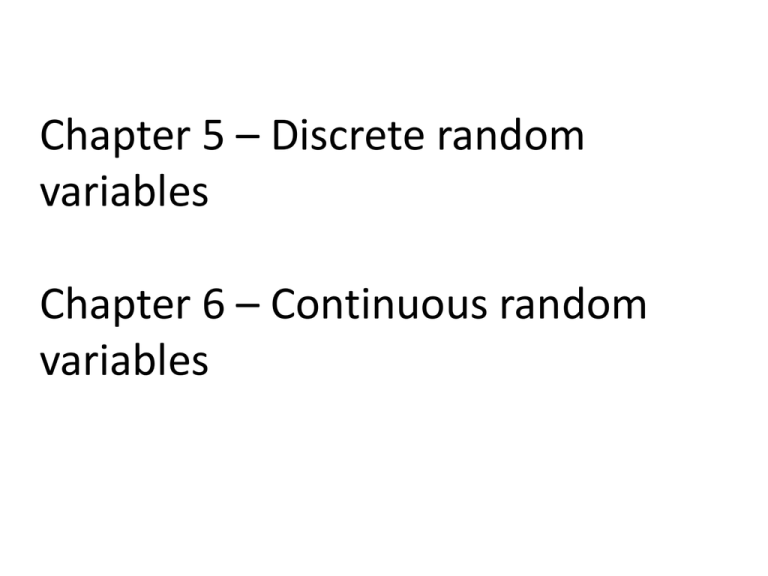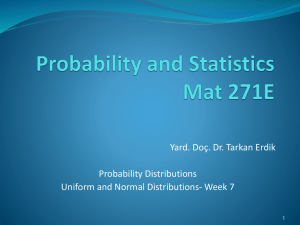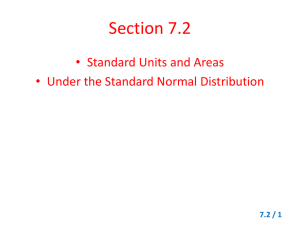Chapter 6 - Faculty @ Bemidji State University
advertisement

Chapter 5 – Discrete random variables Chapter 6 – Continuous random variables Problems with continuous random variables: 1. Infinite and uncountable number of outcomes 2. Can’t list all the outcomes 3. Can’t use a table to write out the probability distribution 4. Calculus required for probability calculations Problems with continuous random variables What do we do!? 1. Use technology for probability calculations 2. Old fashion way – use tabulated probability values in back of book 3. Use graphs to represent probabilities Chapter 6 focuses on one continuous distribution – the normal distribution Normal distribution is also called • Gaussian distribution after Carl Gauss • Bell shaped curve What does the normal distribution look like? What does the normal distribution look like? Properties of normal distribution • • • • • Bell shaped curve One mode Symmetric Centered at it’s mean, μ Tails extend out in both directions to −∞ and ∞ • Standard deviation is σ The mean, μ, gives the location • Distributions I, II, and III have a mean, µ = 0 The mean, μ, gives the location • Distribution IV has a mean, µ = 3 The standard deviation, σ, gives the spread or variability • Distribution III has the smallest standard deviation The standard deviation, σ, gives the spread or variability • Distributions II and IV have equal standard deviations The standard deviation, σ, gives the spread or variability • Distribution I has the greatest standard deviation Properties of normal distribution Properties of normal distribution Let X = uncomplicated human pregnancy length. Assume X has a normal distribution with mean 39 weeks and standard deviation 2 weeks. Approximately how many pregnancies last between 37 and 41 weeks? A. B. C. D. E. About 34% About 68% About 95% About 99.7% 100% Let X = uncomplicated human pregnancy length. Assume X has a normal distribution with mean 39 weeks and standard deviation 2 weeks. Approximately how many pregnancies last more than 43 weeks? A. B. C. D. E. About 68% About 34% About 16% About 5% About 2.5% Let X = uncomplicated human pregnancy length. Assume X has a normal distribution with mean 39 weeks and standard deviation 2 weeks. Approximately how many pregnancies last between 35 and 41 weeks? A. B. C. D. E. About 47.5% About 50% About 81.5% About 95% About 99.7% Weights of adult green sea urchins are normally distributed with a mean of 52 g and a standard deviation of 17.2 g. Find the percentage of adult green sea urchins with weights between 50 and 60 grams. A. B. C. D. E. 22.54% 11.27% 55.14% 53.27% Adult green sea urchins taste good Weights of adult green sea urchins are normally distributed with a mean of 52 g and a standard deviation of 17.2 g. About 12% of adult green sea urchins weigh less than what amount? A. B. C. D. 50.0 g 72.2 g 31.8 g 34.8 g The standard normal distribution has a mean 𝜇 = 0 and a standard deviation 𝜎 = 1. It is sometimes called a z distribution The standard normal distribution is used for calculations – the old fashioned way! How do we know if a sample of data comes from a normal distribution, or not? 118.5 120.3 87.9 99.5 125.7 88.5 100.5 104.7 98.6 92.6 117.6 70.6 101.2 77.2 88.1 116.5 120.0 94.7 94.8 79.5 How do we know if a sample of data comes from a normal distribution, or not? We will look at two ways in this class: 1. Graph the data (histogram) and visually assess the shape. – useful for larger sample sizes, n > 100. 2. Create a normal probability plot – useful for any sample size. Graph the data. Data is from a normal distribution. A. True B. False Graph the data. Data is from a normal distribution. A. True B. False Graph the data. Data is from a normal distribution. A. True B. False Graph the data. Data is from a normal distribution. A. True B. False Graph the data. Data is from a normal distribution. A. True B. False Create a normal probability plot. Plot based on the y = x algebra relationship. The more linear the graph the more likely the data came from a normal distribution. Create a normal probability plot. How to make a normal probability plot: • Calculator • Minitab We can assume this data is from a normal distribution. A. True B. False 13 14 17 13 10 11 13 16 18 18 We can assume this data is from a normal distribution. A. True B. False 9 1 3 17 1 4 5 10 19 1 31 2 28 8 20 We can assume this data is from a normal distribution. A. True B. False 3 9 3 2 9 9 9 10 6 2 8 10 10 7 We can assume this data is from a normal distribution. A. True B. False We can assume this data is from a normal distribution. A. True B. False We can assume this data is from a normal distribution. A. True B. False











